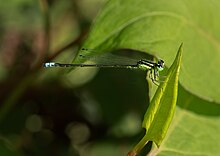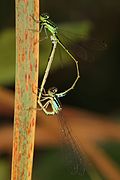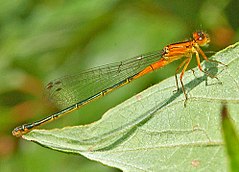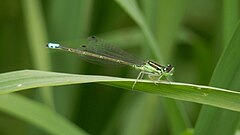323:
335:
359:
347:
56:
42:
105:
80:
280:
can reach a body length of 22–30 millimetres (0.87–1.18 in). These small green, black and blue damselflies have a slender body with four wings folding over the back. The thorax of the males is black above, with pale green sides and green shoulder stripes. Eyes are dark above, greenish below.
310:
Adults typically fly from late June to early
October, but in some locations may extend from early April to early November. Females are commonly monogamous, as they mate only once. They may fertilize over a thousand eggs with the sperm of a single male.
322:
288:
Females are usually grayish-blue, with greyish markings on the abdomen. In the immature female, the thorax is bright orange with black dorsal and shoulder stripes. The abdomen is black above and orange below. Eyes are dark above, orange below. The
281:
Abdomen is mainly black, with thin pale rings. The top of the abdomen (eighth and ninth abdominal segments) is blue, with black markings on sides. The males' abdomens shows tiny projections off the tip (hence the common name
261:
This species is present in the
Eastern United States, from the Atlantic coast to the Midwest and from north of Florida to Southern Canada and west to Montana and New Mexico.
461:
Say, Th. (1839) Descriptions of new North
American neuropterous insects, and observations on some already described., Journal Academy Natural Sciences Philadelphia 8: 9-46.
346:
720:
860:
772:
879:
334:
694:
733:
437:
889:
894:
853:
534:
561:
Fincke, O.M. 1987. Female monogamy in the damselfly
Ischnura verticalis Say (Zygoptera: Coenagrionidae). Odonatologica 16: 129-143.
358:
738:
429:
899:
846:
642:
526:
777:
509:
104:
623:
585:
495:
647:
209:
269:
These damselflies inhabit various wetlands, especially small ponds, slow moving streams and marshes.
407:
302:, or the Western Forktail. These two species can be better distinguished on the basis of their range.
681:
69:
764:
55:
99:
725:
884:
798:
751:
668:
530:
298:
830:
803:
574:
402:
785:
552:
Dubois, Bob. Damselflies of the North Woods. Duluth, MN:Kollath+Stensaas, 2005, p.110-111.
41:
384:
826:
250:
176:
293:
is white to light brown. The females may be less commonly yellow-green like the male.
873:
746:
393:
89:
84:
673:
759:
707:
617:
290:
17:
608:
226:
246:
166:
136:
116:
634:
790:
655:
602:
186:
523:
Dragonflies and
Damselflies of Texas and the South-Central United States
699:
450:
156:
660:
479:
712:
146:
126:
579:
686:
583:
352:
Immature female. The grayish-blue color develops with age
328:
Eastern forktail damselfly mating wheel (male on right)
834:
592:
408:10.2305/IUCN.UK.2017-3.RLTS.T51361720A65836779.en
854:
8:
861:
847:
580:
78:
54:
40:
31:
406:
505:
503:
491:
489:
487:
438:Integrated Taxonomic Information System
375:
318:
475:
473:
471:
469:
467:
7:
822:
820:
548:
546:
880:IUCN Red List least concern species
394:IUCN Red List of Threatened Species
833:. You can help Knowledge (XXG) by
25:
357:
345:
333:
321:
296:This species is very similar to
103:
1:
916:
819:
527:Princeton University Press
890:Insects described in 1839
215:
208:
100:Scientific classification
98:
76:
67:
62:
53:
48:
39:
34:
895:Taxa named by Thomas Say
825:This article related to
521:Abbott, John C. (2005).
510:Wisconsin Odonata Survey
401:: e.T51361720A65836779.
257:Distribution and habitat
383:Paulson, D.R. (2017).
245:) is a member of the
900:Coenagrionidae stubs
451:Encyclopedia of life
27:Species of damselfly
624:Ischnura verticalis
594:Ischnura verticalis
432:Ischnura verticalis
387:Ischnura verticalis
278:Ischnura verticalis
242:Ischnura verticalis
219:Ischnura verticalis
70:Conservation status
285:of this species).
201:I. verticalis
842:
841:
814:
813:
799:Open Tree of Life
586:Taxon identifiers
299:Ischnura perparva
234:
233:
93:
35:Eastern forktail
16:(Redirected from
907:
863:
856:
849:
821:
807:
806:
794:
793:
781:
780:
768:
767:
755:
754:
742:
741:
729:
728:
716:
715:
703:
702:
690:
689:
677:
676:
664:
663:
651:
650:
638:
637:
628:
627:
626:
613:
612:
611:
581:
562:
559:
553:
550:
541:
540:
518:
512:
507:
498:
493:
482:
477:
462:
459:
453:
448:
442:
441:
426:
420:
419:
417:
415:
410:
380:
361:
349:
337:
325:
237:Eastern forktail
221:
108:
107:
87:
82:
81:
58:
44:
32:
21:
18:Eastern Forktail
915:
914:
910:
909:
908:
906:
905:
904:
870:
869:
868:
867:
817:
815:
810:
802:
797:
789:
786:Observation.org
784:
776:
771:
763:
758:
750:
745:
737:
732:
724:
719:
711:
706:
698:
693:
685:
680:
672:
667:
659:
654:
646:
641:
633:
631:
622:
621:
616:
607:
606:
601:
588:
571:
566:
565:
560:
556:
551:
544:
537:
529:. p. 141.
520:
519:
515:
508:
501:
496:Odonata Central
494:
485:
478:
465:
460:
456:
449:
445:
428:
427:
423:
413:
411:
382:
381:
377:
372:
365:
362:
353:
350:
341:
340:Eggs deposition
338:
329:
326:
317:
308:
275:
267:
259:
230:
223:
217:
204:
102:
94:
83:
79:
72:
28:
23:
22:
15:
12:
11:
5:
913:
911:
903:
902:
897:
892:
887:
882:
872:
871:
866:
865:
858:
851:
843:
840:
839:
827:Coenagrionidae
812:
811:
809:
808:
795:
782:
769:
756:
743:
730:
717:
704:
691:
678:
665:
652:
639:
629:
614:
598:
596:
590:
589:
584:
578:
577:
570:
569:External links
567:
564:
563:
554:
542:
535:
513:
499:
483:
463:
454:
443:
421:
374:
373:
371:
368:
367:
366:
363:
356:
354:
351:
344:
342:
339:
332:
330:
327:
320:
316:
313:
307:
304:
274:
271:
266:
263:
258:
255:
251:Coenagrionidae
232:
231:
224:
213:
212:
206:
205:
198:
196:
192:
191:
184:
180:
179:
177:Coenagrionidae
174:
170:
169:
164:
160:
159:
154:
150:
149:
144:
140:
139:
134:
130:
129:
124:
120:
119:
114:
110:
109:
96:
95:
77:
74:
73:
68:
65:
64:
60:
59:
51:
50:
46:
45:
37:
36:
26:
24:
14:
13:
10:
9:
6:
4:
3:
2:
912:
901:
898:
896:
893:
891:
888:
886:
883:
881:
878:
877:
875:
864:
859:
857:
852:
850:
845:
844:
838:
836:
832:
828:
823:
818:
805:
800:
796:
792:
787:
783:
779:
774:
770:
766:
761:
757:
753:
748:
744:
740:
735:
731:
727:
722:
718:
714:
709:
705:
701:
696:
692:
688:
683:
679:
675:
670:
666:
662:
657:
653:
649:
644:
640:
636:
630:
625:
619:
615:
610:
604:
600:
599:
597:
595:
591:
587:
582:
576:
575:Cirrus Images
573:
572:
568:
558:
555:
549:
547:
543:
538:
536:0-691-11364-5
532:
528:
524:
517:
514:
511:
506:
504:
500:
497:
492:
490:
488:
484:
481:
476:
474:
472:
470:
468:
464:
458:
455:
452:
447:
444:
439:
435:
433:
425:
422:
409:
404:
400:
396:
395:
390:
388:
379:
376:
369:
360:
355:
348:
343:
336:
331:
324:
319:
314:
312:
305:
303:
301:
300:
294:
292:
286:
284:
279:
272:
270:
264:
262:
256:
254:
252:
248:
244:
243:
238:
229:, 1839)
228:
222:
220:
214:
211:
210:Binomial name
207:
203:
202:
197:
194:
193:
190:
189:
185:
182:
181:
178:
175:
172:
171:
168:
165:
162:
161:
158:
155:
152:
151:
148:
145:
142:
141:
138:
135:
132:
131:
128:
125:
122:
121:
118:
115:
112:
111:
106:
101:
97:
91:
86:
85:Least Concern
75:
71:
66:
63:Adult female
61:
57:
52:
47:
43:
38:
33:
30:
19:
835:expanding it
824:
816:
593:
557:
522:
516:
457:
446:
431:
424:
412:. Retrieved
398:
392:
386:
378:
309:
297:
295:
287:
282:
277:
276:
268:
260:
241:
240:
236:
235:
218:
216:
200:
199:
187:
29:
760:NatureServe
708:iNaturalist
618:Wikispecies
291:pterostigma
273:Description
49:Adult male
874:Categories
370:References
283:verticalis
163:Suborder:
137:Arthropoda
480:Bug Guide
247:damselfly
195:Species:
167:Zygoptera
123:Kingdom:
117:Eukaryota
885:Ischnura
765:2.111529
752:51361720
726:11277099
656:BugGuide
632:BioLib:
609:Q1634022
603:Wikidata
188:Ischnura
173:Family:
133:Phylum:
127:Animalia
113:Domain:
90:IUCN 3.1
700:1423305
315:Gallery
306:Biology
265:Habitat
249:family
183:Genus:
157:Odonata
153:Order:
147:Insecta
143:Class:
88: (
804:749174
739:102079
687:234747
635:227817
533:
414:23 May
829:is a
791:80525
778:88053
721:IRMNG
713:84722
674:3Q6H8
648:94700
831:stub
773:NCBI
747:IUCN
734:ITIS
695:GBIF
661:4983
643:BOLD
531:ISBN
416:2023
399:2017
364:Male
682:EoL
669:CoL
403:doi
227:Say
876::
801::
788::
775::
762::
749::
736::
723::
710::
697::
684::
671::
658::
645::
620::
605::
545:^
525:.
502:^
486:^
466:^
436:.
397:.
391:.
253:.
862:e
855:t
848:v
837:.
539:.
440:.
434:"
430:"
418:.
405::
389:"
385:"
239:(
225:(
92:)
20:)
Text is available under the Creative Commons Attribution-ShareAlike License. Additional terms may apply.





